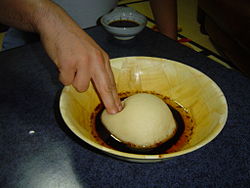This article needs additional citations for verification. (January 2021) |
 | |
| Type | Pudding |
|---|---|
| Region or state | Abbasid Caliphate |
| Main ingredients | wheat flour, butter or honey |
Asida (Arabic "عصيدة", Maghrebi "Ġsydë" [ˈʕæs(ˁ)iːdə]) is a common dish in the Arab world.[1] It is a lump of dough, obtained by stirring wheat flour into boiling water, sometimes with added butter or honey. Similar in texture to fufu, it is eaten mainly in Middle East and African countries. It is considered one of the most popular desserts and traditional dishes in many Arab countries.
Asida is particularly popular in Sudan, Morocco, Libya, Algeria, Tunisia, Yemen, Ethiopia, Eritrea, and the rest of the Middle East. Often served during religious holidays such as Mawlid and Eid, it is also served during other traditional ceremonies, for example accompanying the birth of child, such as the ‘aqīqah, the cutting of the hair of a newborn seven days after birth.[2]
A simple, yet rich dish, often eaten without other complementary dishes, it is traditionally served at breakfast and is also given to women in labor.[2]
- ^ Nzeribe, Nympha (14 July 2022). "Aseeda". afrifoodnetwork.com/. Retrieved 31 January 2023.
- ^ a b Famous Everyday Dishes from the Medieval Arab World